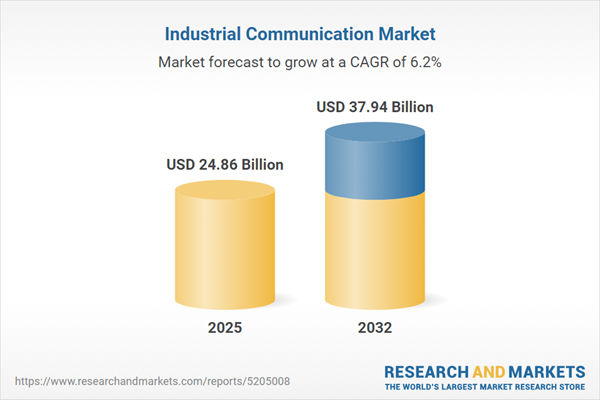Speak directly to the analyst to clarify any post sales queries you may have.
Industrial communication technology is transforming manufacturing and logistics by seamlessly uniting operations with data-driven intelligence. As organizations accelerate digital initiatives, clarity and strategic insight are vital for senior leaders focused on connectivity, compliance, and operational modernization.
Market Snapshot: Current Size and Growth Trajectory in the Industrial Communication Market
The global industrial communication market stood at USD 23.46 billion in 2024 and is anticipated to reach USD 24.86 billion by 2025, marking a consistent compound annual growth rate of 6.19% expected through 2032. This outlook highlights the increasing value of digital platforms for optimizing enterprise connectivity and operational efficiency on a worldwide scale. Market progress is sustained by ongoing network infrastructure investments, stronger security protocols, and regulatory-ready environments designed for resilience. For executive decision-makers, the ability to deploy scalable infrastructures is critical to managing compliance obligations and navigating technological as well as regulatory transitions.
Scope & Segmentation: Deep Dive into Industrial Communication Dynamics
- Communication Types: The adoption of wired and wireless networking solutions—including LPWAN, WLAN, and WPAN technologies—builds system reliability and supports scalable infrastructures. This flexibility enables companies to integrate legacy assets with advanced systems for robust, future-ready operations.
- Component Categories: Gateways, routers, industrial switches, interface cards, and specialized software, combined with advanced cybersecurity measures, form the foundation for efficient, secure communication. These components are pivotal in minimizing workflow interruptions, improving adaptability, and securing critical industrial environments.
- End User Sectors: Key industries such as aerospace, agriculture, automotive, chemicals, energy, food and beverage, metals, mining, oil and gas, pharmaceuticals, and electronics leverage these systems for comprehensive process automation and stringent compliance management amid shifting industry demands.
- Regional Coverage: The Americas focus on digital innovation and transformation, EMEA emphasizes sustainability and workflow efficiency, and Asia-Pacific demonstrates rapid industrial tech adoption with frequent regulatory and operational adjustments across supply chains.
- Company Analysis: Industry leaders—including Cisco Systems, Belden, ABB, Honeywell, Intel, Mitsubishi Electric, Siemens, SAP, Microsoft, and Texas Instruments—champion secure automation and integrated connectivity, supporting market responsiveness and establishing operational standards.
Key Takeaways: Strategic Insights for Decision-Makers
- Upgrading infrastructure enhances flexibility and scalability, allowing businesses to remain competitive during technological upgrades and organizational shifts.
- Integrating operations and information technologies ensures access to real-time data, supporting faster, evidence-based management decisions, especially under volatile conditions.
- Combining wired and wireless methods secures continuous connectivity for remote sites and critical assets with minimal downtime or service gaps.
- Developing robust cybersecurity frameworks is essential for maintaining regulatory alignment and proactively managing operational security risks.
- Applying artificial intelligence and machine learning supports continuous monitoring, optimizes asset performance, and streamlines predictive maintenance, leading to improved operational visibility and reduced disruptions.
- Aligning technological investments with environmental and compliance goals enables prompt adaptation to global and local regulatory changes, strengthening organizational agility.
Tariff Impact: Navigating United States Trade Disruption in Supply Chains
Recent tariff measures in the United States impacting industrial communication components are prompting organizations to reevaluate procurement and risk management strategies. Senior leaders are leveraging digital procurement platforms to improve sourcing transparency and reexamining supplier relationships to strengthen resilience. Stronger partnerships with logistics and transport providers help sustain operational efficiency during regulatory and supply chain changes.
Methodology & Data Sources
This report draws on direct interviews with industry leaders, comprehensive analysis of company disclosures, and a review of respected market publications. The multi-source methodology offers senior executives dependable, actionable insights for strategic planning and managing risk in the industrial communication sector.
Why This Report Matters
- Provides actionable guidance, enabling executives to lead digital transformation and manage operational risk with greater confidence amidst complex challenges.
- Serves as a practical resource for optimizing workflows and supply chains while supporting compliance with evolving regulatory and sustainability requirements.
- Offers understanding of pivotal trends, helping organizations anticipate market changes and seize strategic opportunities for ongoing growth and compliance.
Conclusion
Industrial communication technology is a core enabler of operational agility and enterprise resilience. Focused implementation helps leaders meet modernization targets while adapting to dynamic market and regulatory landscapes.
Additional Product Information:
- Purchase of this report includes 1 year online access with quarterly updates.
- This report can be updated on request. Please contact our Customer Experience team using the Ask a Question widget on our website.
Table of Contents
3. Executive Summary
4. Market Overview
7. Cumulative Impact of Artificial Intelligence 2025
Companies Mentioned
The companies profiled in this Industrial Communication market report include:- Cisco Systems, Inc.
- Belden Inc.
- Aaeon Technology Inc.
- ABB Ltd.
- Advantech Co., Ltd.
- B+M Blumenbecker GmbH
- General Electric Company
- Honeywell International Inc.
- IFM Electronic GmbH
- Industrial Communications, LLC
- Intel Corporation
- International Business Machines Corporation
- Microsoft Corporation
- Mitsubishi Electric Corporation
- Molex, LLC
- Moxa Inc.
- Nokia Corporation
- Omron Corporation
- Pepperl+Fuchs SE
- Phoenix Contact Gmbh & Co. Kg
- Renesas Electronics Corporation
- Robert Bosch AG
- Rockwell Automation, Inc.
- SAP SE
- Schneider Electric SE
- Sick AG
- Siemens AG
- STMicroelectronics N.V.
- Telefonaktiebolaget LM Ericsson
- Texas Instruments
- Tridon Communications
Table Information
| Report Attribute | Details |
|---|---|
| No. of Pages | 192 |
| Published | November 2025 |
| Forecast Period | 2025 - 2032 |
| Estimated Market Value ( USD | $ 24.86 Billion |
| Forecasted Market Value ( USD | $ 37.94 Billion |
| Compound Annual Growth Rate | 6.1% |
| Regions Covered | Global |
| No. of Companies Mentioned | 32 |









